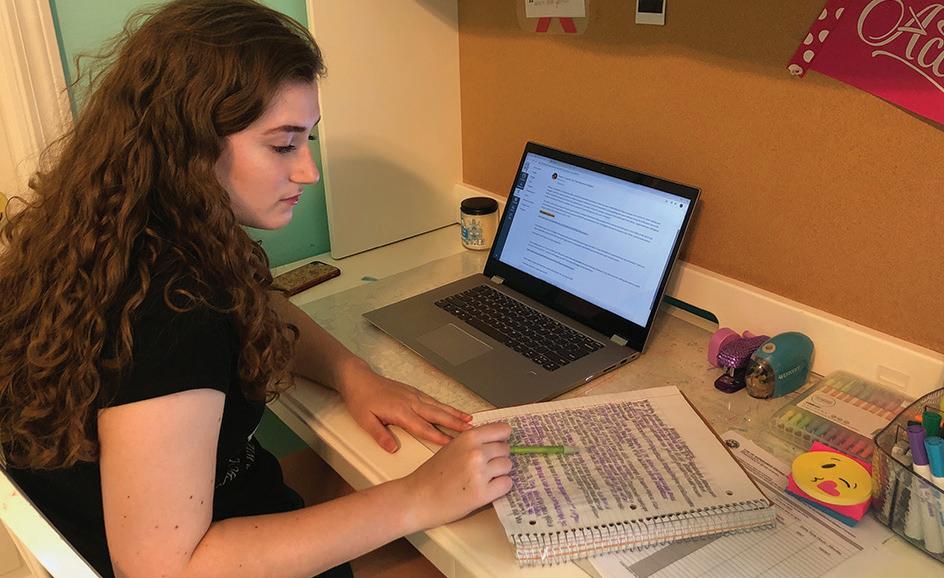
4 minute read
A VIRTUAL REALITY
from 8.13 Issue
by HiLite News
This year’s virtual learning to focus on social-emotional learning, bonds between teachers, students
WENDY ZHU STORY SAM HAWKINS GRAPHIC SARAH KONRAD SUBMITTED PHOTOS
Advertisement
In the 2019-2020 school year, teachers taught the final quarter of school entirely online after Carmel Clay Schools (CCS) closed on March 16 and Gov. Holcomb later ordered all K-12 schools in Indiana to remain closed for the rest of the school year. It’s likely that most, if not all teachers were not expecting to deal with a global pandemic and a full shift to virtual learning. Over the summer, however, hundreds of CCS teachers attended professional development workshops for virtual learning, including sessions on enhancing Canvas use and building a classroom culture online. Though CCS is set to reopen its doors today and resume in-person classes, virtual learning options are available to students as well.
According to Principal Tom Harmas, this year’s virtual learning will place a heavier emphasis on social-emotional learning (SEL). SEL includes the development of interpersonal skills, learning how to manage emotions and goal-setting, and it helped inspire Carmel’s Culture of Care.
“We’re very fortunate because most of our students are self-driven and want to do well in school, but
STUDY TIME:
(LEFT) Senior Sarah Konrad takes notes for class during onlinelearning time. She said she had trouble for the first few days, but did her best to find a schedule to help her get things turned in on time.
(RIGHT): Senior Sarah Konrad shares some of her notes for class. for those who aren’t, it was difficult for us to have that communication and really help those kids that weren’t having a difficult time,” Harmas said. “That’s part of that SEL piece, creating a classroom culture and really trying to reach out to kids, making sure they know they have a partner in education—somebody who really cares about them—and that we want them to do well and we’re going to help them in any way that we possibly can.”
While seeing someone’s face through a screen and hearing someone’s voice through speakers isn’t the same as seeing and hearing them in

person, conference calls through platforms like Zoom are often the closest students and teachers can get to a classroom setting in the confines of their homes. Senior Sarah Konrad said she hopes teachers will hold more conference calls for virtual learners this year, as some of her previous teachers did not hold any last school year.
“I love the classroom environment,” Konrad said. “I love getting to see everyone’s faces. I wish more teachers had held Zooms for us so that we could see each other and also see the teacher rather than just having this icon on a screen sending us a Canvas announcement. I wanted the human element.”
Harmas also encouraged teachers to hold more conference calls and live classes with students, describing the digital disconnect of virtual learning as something that could disrupt the bond between teacher and student.
“I think that education is about relationships, and it is more difficult to create a relationship virtually,” Harmas said. “I’m from the relationship generation, with the belief that when you can see a person’s face, when you can really hear their tone, you can better understand them. If you’re not doing Zoom classes and so forth, it’s difficult to get a read.”
Last school year, social studies teacher Sandy Gardner held several Zoom calls with her classes and also reached out to individual students who were struggling. She said many of her best conversations with students were one-on-one or in small groups, where students could get feedback catered more specifically to them. After having these individual conferences, she found that many students who initially felt overwhelmed were able to get back on track. For those who will continue virtual learning, Gardner said reaching out to teachers is key to being a successful student when not in an actual classroom.
“Communicate with teachers when you don’t understand what’s going on,” Gardner said. “You can’t just let it go. You can’t just be like, ‘Oh, I can’t figure it out’ and move
BY THE NUMBERS 1 MILLION
Students were enrolled in K-12 schools in Indiana during the 2019-2020 school year
48
States suspended all in-person classes through the end of the 2019-2020 school year
THE CUT, EDWEEK SOURCES on. And that’s a good lesson—you have to do that in life. You have to do that when you get a job, and you have to empower yourself to ask questions and get clarification so you can do your best work.”
Many questions about this school year still remain a mystery, especially as experts like Dr. Lisa Maragakis of Johns Hopkins Medicine have cautioned that a second wave of COVID-19 could possibly occur in the fall. However, Harmas said students and staff dealt well with the beginning of the pandemic in the spring, and if a complete return to virtual learning were necessary this year, he said teachers would remain flexible and communicative as much as possible.
“I really want to emphasize how proud I was of how our teachers and our students accepted the challenge and reacted in a positive manner to starting virtual learning right away,” Harmas said. “I want to make sure that everyone knows that... we’re doing professional development, and we’re getting better at what we do. It’s all about being able to meet the students’ needs.” H
NOTHING NEW
Take a look at how nearby school districts used online learning prior to COVID-19 closures
Noblesville
Zionsville Community Carmel Clay
Hamilton Southeastern
Summer school Snow days Alongside traditional learning
Pike Township
Indianapolis Public Washington Township Lawrence
Township Metropolitan CCS, ZCS HSE, IPS, MSD OF PIKE TOWNSHIP, WASHIINGTON TOWNSHIP, LAWRENCE
TOWNSHIP, NOBLESVILLE SCHOOLS SOURCES






